|
|
|
|
|
|
|
|
|
|
|
|
|
|
|
|
 |
|
|
 |
|
|
 |
|
|
|
 |
 |
 |
| One of the more common decorations seen in glass rose bowls are those round spots or dots that we all love. I thought an article exploring the variations of this technique and showing some examples with proper identification would be of interest. |
|
| In the beginning, dating to Victorian times, would have been what we call the thumbprint - pressed into the glass object as if pushed in by the thumb from the outside. Following that, perhaps, came the reverse thumbprint where the imprint would be made from the inside - thus producing a "bump" on the outside surface. (I find it easier to feel the inside of a rose bowl to feel which way the prints go as the outside is often flattened by the mold surface.) Thumbprints were then arranged in rows to form a more intricate overall pattern. Of course, in modern times, manufacturers liked to give their thumbprint type glass specific pattern names to differentiate from the competition. |
 |
|
|
 |
 |
 |
 |
 |
|
 |
|
|
|
 |
 |
 |
| The lower two bowls in Figure 1, for instance, are in Fentons version of a "baby" thumbprint. I believe the Jamestown Blue Transparent bowl on the left was made first (1957-59) and the pattern was called "Polka Dot Optic". At a later date, the Ruby Overlay color on the right was introduced - the pattern then seems to be called "Fine Dot". The bowl in the back in Figure 1 is L. G. Wrights "Honeycomb" in satin finish opalescent cranberry |
 |
|
|
 |
 |
 |
 |
 |
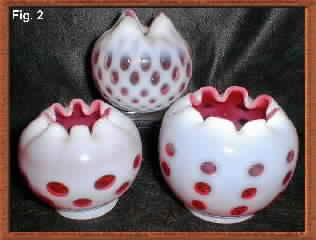 |
|
 |
 |
|
|
|
 |
 |
 |
| At the bottom of Figure 2, we have somewhat similar bowls by Fenton and Wright. To the left, with the staggered dots not coming up as close to the top - we have Fentons "Coin Dot". On the right is Wrights "Eye Dot". Both pieces are in cranberry opalescent. The bowl at the top of Figure 2 is from Intaglio Glass Co. and dates from the 1970s. As far as I can determine - it does not have a specific name. (An interesting sidelight is that the owner of Intaglio had earlier been a partner in Levay which had a business relationship with Fenton). |
 |
|
|
 |
 |
 |
 |
 |
 |
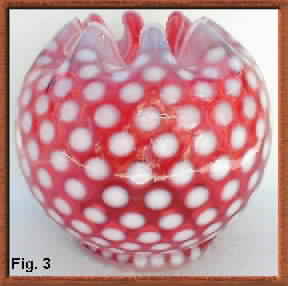 |
|
 |
|
|
|
 |
 |
 |
| The bowl in Figure 3 is Fenton's "Polka Dot", characterized by staggered rows of spots and a band of white opalescence around the crimps. This pattern I believe is circa 1955. |
 |
|
|
 |
 |
 |
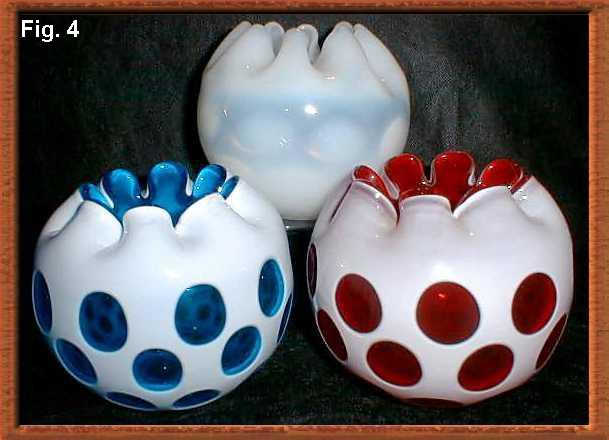 |
|
 |
|
|
|
 |
 |
 |
| At the bottom of Figure 4 are two bowls made in an entirely different way. These bowls, one cobalt and one cranberry, started life completely cased in white - which was then ground away in a slightly concave manner (thumbprint) until it was through to the inner colored glass. Because these little ground windows or optic eyes are concave, when you look into them, you see many small images of the spots on the other side. That is why they are often called "thousand eyes". The third bowl in this picture is a more conventionally formed thumbprint in white opalescent. It is believed that all three of these bowls are late models - possibly made in Japan. A good tip off to their origin is their ground smooth bottoms. Both Fenton and Jefferson did make bowls similar to the one at the top which I believe were called "Coinspot". |
 |
|
|
 |
 |
 |
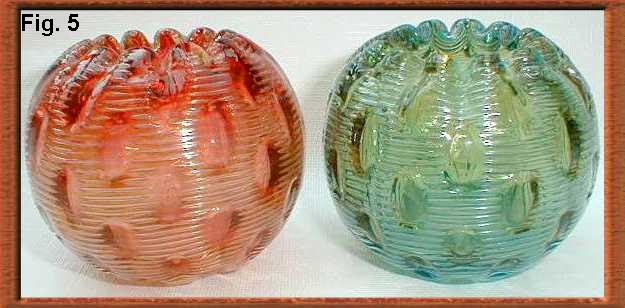 |
|
 |
|
|
|
 |
 |
 |
| Next, in Figure 5, are two antique bowls from that venerable English glass house - Stevens & Williams. These are formed with reverse thumbprints in the threaded glass ground - yielding an interesting dot effect which was called "raindrop". |
 |
|
|
 |
 |
 |
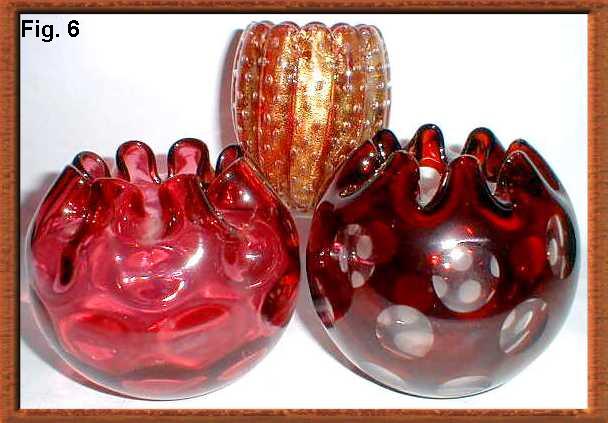 |
|
 |
 |
|
|
|
 |
 |
 |
| Finally, in Figure 6, on the left is another Japanese cranberry bowl in a large thumbprint motif. Wright made similar bowls but in their classic wafer footed style. On the right is another imported "thousand eyes" - this one ground through the ruby exterior to the clear interior. In the top bowl, captured controlled size bubbles of air between two layers of glass also give a dot effect. This is likely from the Italian maker Barovier and made in the 1950s. |
|
| Well, I hope this little tour of dot embellished rose bowls has given you a basic understanding of this decorative form. It is by no means meant to be comprehensive as this was an immensely popular theme and made in many shapes and colors. I have purposely not touched on "hobnail" bowls, for instance as these could be the subject for an entirely new article. |
 |
|
|
 |
 |
 |
 |
 |
 |
 |
|





